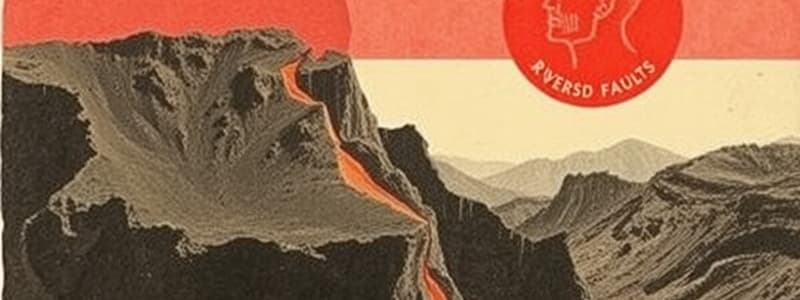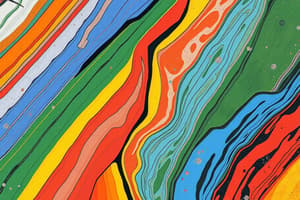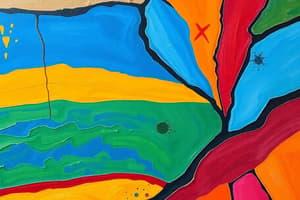Podcast
Questions and Answers
In a reverse fault, which direction does the hanging wall move relative to the footwall, and what type of stress is primarily responsible for this movement?
In a reverse fault, which direction does the hanging wall move relative to the footwall, and what type of stress is primarily responsible for this movement?
- Hanging wall moves downward; compression.
- Hanging wall moves upward; compression. (correct)
- Hanging wall moves downward; tension.
- Hanging wall moves upward; tension.
Which type of fault is characterized by horizontal movement, where rocks slide past each other, and at what plate boundary does this typically occur?
Which type of fault is characterized by horizontal movement, where rocks slide past each other, and at what plate boundary does this typically occur?
- Normal fault; convergent boundary.
- Thrust fault; subduction zone.
- Strike-slip fault; transform boundary. (correct)
- Reverse fault; divergent boundary.
What type of stress is most commonly associated with the formation of normal faults, and where are these faults typically found?
What type of stress is most commonly associated with the formation of normal faults, and where are these faults typically found?
- Confining stress; continental interiors.
- Shear stress; transform boundaries.
- Compressional stress; subduction zones.
- Tensional stress; divergent boundaries. (correct)
Which of the following scenarios is most likely to generate a significant tsunami?
Which of the following scenarios is most likely to generate a significant tsunami?
What is the primary cause of an earthquake shadow zone, and how does it affect the detection of seismic waves?
What is the primary cause of an earthquake shadow zone, and how does it affect the detection of seismic waves?
How does the behavior of a tsunami wave change as it moves from deep ocean water to shallow coastal waters?
How does the behavior of a tsunami wave change as it moves from deep ocean water to shallow coastal waters?
What type of seismic wave is the fastest and can travel through solids, liquids, and gases?
What type of seismic wave is the fastest and can travel through solids, liquids, and gases?
Which of the following best describes the elastic rebound theory?
Which of the following best describes the elastic rebound theory?
How do compressional forces contribute to mountain formation at convergent plate boundaries?
How do compressional forces contribute to mountain formation at convergent plate boundaries?
Which scale is used to measure the intensity of an earthquake based on its observed effects on people and structures?
Which scale is used to measure the intensity of an earthquake based on its observed effects on people and structures?
Flashcards
Normal Fault
Normal Fault
A fault where the hanging wall moves downward relative to the footwall due to tensional forces.
Reverse Fault
Reverse Fault
A fault where the hanging wall moves upward relative to the footwall due to compressional forces.
Thrust Fault
Thrust Fault
A special type of reverse fault with a low-angle slope (less than 30 degrees) resulting from strong compression.
Strike-Slip/Transform Fault
Strike-Slip/Transform Fault
Signup and view all the flashcards
Compressional Forces
Compressional Forces
Signup and view all the flashcards
Tensional/Extensional Forces
Tensional/Extensional Forces
Signup and view all the flashcards
Shear Forces
Shear Forces
Signup and view all the flashcards
Elastic Rebound
Elastic Rebound
Signup and view all the flashcards
Tsunami
Tsunami
Signup and view all the flashcards
Focus of an Earthquake
Focus of an Earthquake
Signup and view all the flashcards
Study Notes
Fault Types and Motion
- Normal faults feature the hanging wall moving downward relative to the footwall
- This is due to tensional forces
- Normal faults are common at divergent boundaries, like the East African Rift Valley
- Reverse faults feature the hanging wall moving upward relative to the footwall
- This is due to compressional forces
- Reverse faults are common at convergent boundaries
- Examples include the Himalayas and the Rocky Mountains
- Thrust faults are a type of reverse fault with a low-angle slope (less than 30 degrees)
- They result from strong compression
- They thicken the crust and form mountain belts, such as the Alps, Andes, and Himalayas
- Strike-Slip/Transform faults involve rocks sliding past each other horizontally due to shear forces
- There is little to no vertical movement
- These faults occur at transform plate boundaries, such as the San Andreas Fault in California and the North Anatolian Fault in Turkey
Tectonic Forces
- Compressional forces push rocks together, causing them to shorten and thicken
- This leads to folding and reverse faults
- Compressional forces form mountains at convergent plate boundaries, like the Himalayas
- Tensional/Extensional forces pull rocks apart, causing them to stretch and become thinner
- This results in normal faults and rift valleys, like the East African Rift
- Tensional forces occur at divergent plate boundaries, such as the Mid-Atlantic Ridge
- Shear forces cause rocks to slide past each other in opposite directions
- This leads to strike-slip faults, such as the San Andreas Fault in California
- Shear forces are the most common at transform plate boundaries
Earthquake Epicenter
- It takes 1 minute between the P and S wave
Earthquake Damage Factors
- The amount of structural damage from earthquake vibrations depends on factors like:
- The type of building
- The earthquake's duration
Earthquake Measurement Scales
- The Modified Mercalli Scale measures earthquake intensity based on observed effects
- The Richter Magnitude Scale measures the energy released by an earthquake
Earthquake Shadow Zone
- An earthquake shadow zone is where seismic waves are not detected on Earth's surface
- Seismic waves interact with the Earth's internal layers
- The P-wave shadow zone is between 103° and 142° from the epicenter
- The S-wave shadow zone begins at 103° and extends around the globe
Tsunami Formation
- Tsunamis typically form on the ocean floor at convergent boundaries involving an earthquake at a subduction zone
- A megathrust earthquake causes the overriding plate to rise suddenly
- This displaces a large amount of water and initiates the tsunami
Tsunami Wave Propagation
- Disturbance creates waves traveling outward at 500-800 km/h
- In deep water, waves have long wavelengths (100-200 km) and are a few meters high
Tsunami Approaching Shore
- As the tsunami reaches shallow water, the seafloor becomes shallower
- This causes the waves to slow down due to friction
- Wave energy compresses
- The wave height increases dramatically through wave shoaling
- Waves can grow 10-30+ meters tall depending on the coastline
Tsunami Impact
- The first sign is often a rapid withdrawal of water (drawback)
- The crest of the wave follows, causing immense flooding
- Tsunamis feature powerful surges that can last for minutes or hours
- Flooding destroys infrastructure and landscapes
- Water recedes, dragging debris and people out to sea
- Multiple waves and aftershocks may occur
Faults and Tsunamis
- Reverse (Thrust) faults trigger most tsunamis
- Megathrust earthquakes at subduction zones cause the overriding plate to shift upward, displacing water
- Normal faults create smaller tsunamis due to less water displacement
- Strike-Slip faults do not generally cause tsunamis
- Strike-Slip faults can trigger underwater landslides, which in turn generate local tsunamis
Tsunami Speed
- Tsunami speed depends on its water dpeth
- In deep ocean (5500 meters): 835 km/hr
- At 900 meters depth: 340 km/hr
- At 20 meters depth: 50 km/hr
Earthquake Definitions
- Earthquake: A sudden shaking from released energy in rocks, usually along faults
- Focus: The point inside the Earth where an earthquake originates (hypocenter)
- Epicenter: The point on the Earth's surface directly above the focus
- Fault: A fracture in the Earth's crust where movement occurs
- H.F. Reid: Geologist who developed the elastic rebound theory
- Elastic Rebound: Rocks deform elastically until they break
- Foreshock: A smaller earthquake before the main one
- Aftershock: A smaller earthquake after the main one
- Elastic Energy: Stored energy in rocks released during an earthquake
- Frictional Force: Resistance between surfaces preventing movement
- San Andreas Fault: A major strike-slip fault in California
- Fault Creep: Slow, gradual movement along a a fault
- Seismology: The scientific study of earthquakes and seismic waves
- Surface Waves: Seismic waves traveling along the Earth's surface
- Body Waves: Seismic waves traveling through the Earth's interior (P-waves and S-waves)
- Primary (P) Waves: Fast seismic waves traveling through solids, liquids, and gases
- Secondary (S) Waves: Slower seismic waves traveling through solids only
- Modified Mercalli Intensity Scale: Measures earthquake intensity based on observed effects (I to XII)
- Tsunami: A large sea wave generated by earthquakes, eruptions, or landslides
- Magnitude (Richter Scale): Measures energy released by an earthquake
- Wave Amplitude: Wave height determining seismic or tsunami waver strength
- Moment Magnitude Scale (Mw): Measures earthquake magnitude
- Shadow Zone: Area on Earth's surface without seismic waves
Studying That Suits You
Use AI to generate personalized quizzes and flashcards to suit your learning preferences.




